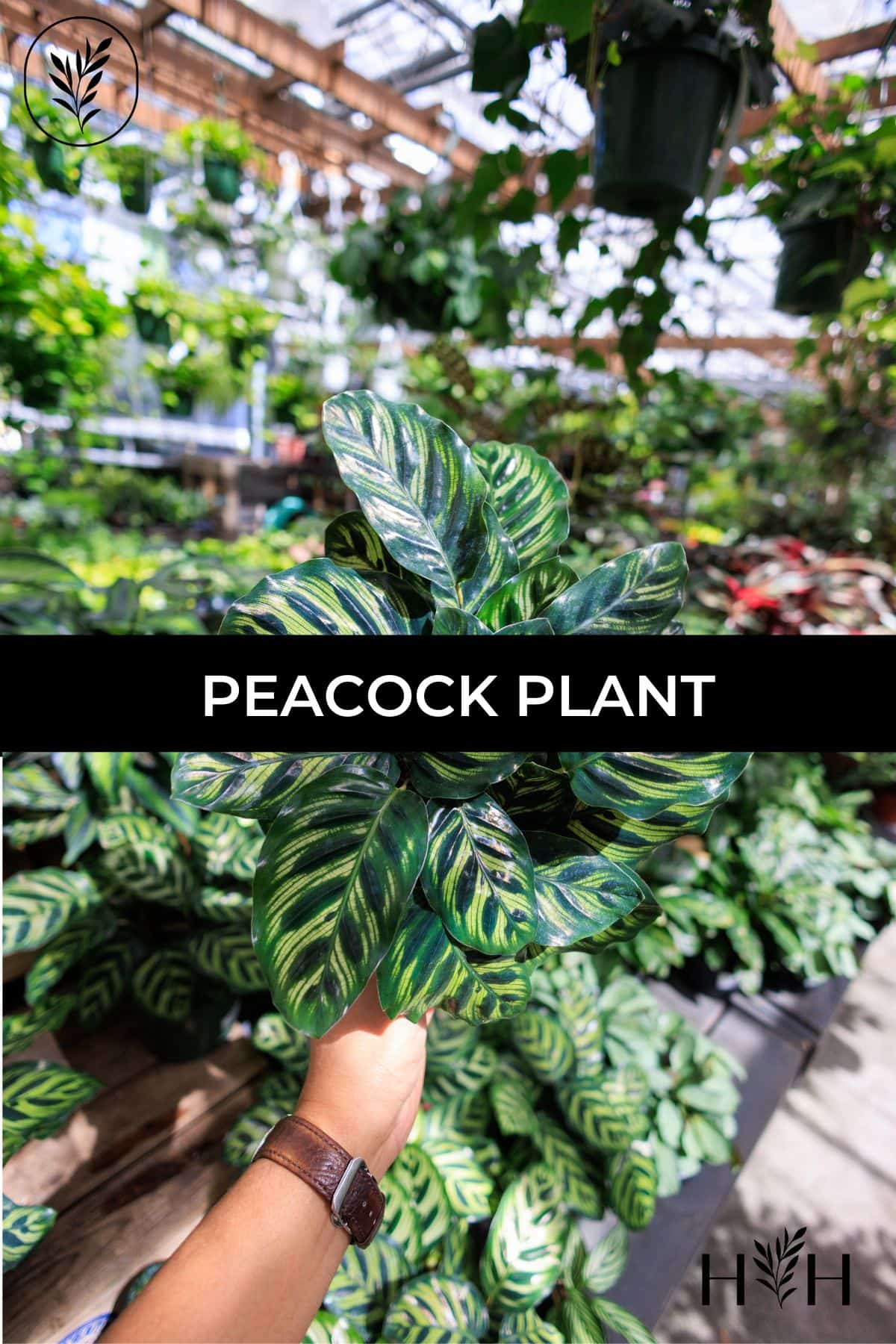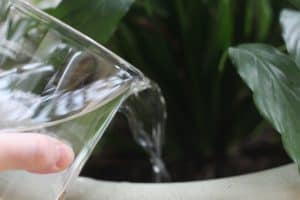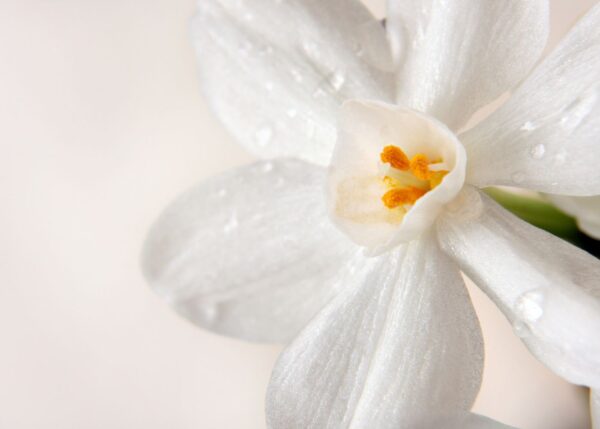Looking for a striking houseplant to add to your collection? The peacock plant is a fantastic choice!
The peacock plant (Goeppertia makoyana) is a tropical plant native to Brazil that is commonly grown as an indoor houseplant. Peacock plants are known for their ornamental patterned foliage. These rainforest plants grow best in humid environments out of direct sunlight.
Read on to learn all about Peacock Plant and how to care for it!

Peacock plant basics
Peacock Plants (Goeppertia makoyana) are tropical houseplants known for their striking leaves and love of humidity. The leaves are green with dark and light green stripes on one side and often a deep maroon on the back, giving off the impression of a Peacock. Although they are somewhat needier than other houseplants, Peacock Plants make wonderful additions to your home given the proper care. In addition, these plants are pet-friendly, making them perfect for households with furry friends (source: ASPCA).
The peacock plant has the botanical Latin name Goeppertia makoyana. Previously, this plant was classified as Calathea makoyana. Many gardeners and plant shops still refer to the peacock plant as a “Calathea” in common settings. The genus Goeppertia is in the family Marantaceae. A related popular houseplant in the Marantaceae family is the Prayer Plant, which sometimes leads to the Peacock Plant being called the “Peacock Prayer Plant”. Goeppertia makoyana (Peacock Plant) was given the Royal Horticultural Society’s Award of Garden Merit in 1993.

Buying peacock plants
You can purchase a Peacock Plant at your local garden center or an online plant store. Most baby-sized Peacock Plants cost around $20-$30 in a 4″-6″ plastic nursery pot. Look for plants labeled either Calathea makoyana or Goeppertia makoyana on the tag.

Peacock plant care guide
Peacock plant care is mainly about providing a humid environment with good air circulation, as well as keeping the soil a bit moist but not soggy or muddy. Here are all the details about caring for peacock plant.
Watering peacock plant
Peacock plants love moist soil, but not fully saturated soil. Overwatering causes the soil to become soggy and muddy, which is not ideal for these plants.
Only water your plant when the top half-inch of soil is dry to prevent overwatering. Ensure that excess water can drain freely out of the bottom of the pot. You can check the moisture levels by sticking a finger into the soil, or you can purchase a moisture meter for added accuracy.
In addition, peacock plants are picky about their water quality. They are highly sensitive to fluoride levels in hard water or tap water, meaning they need filtered water, bottled water, or rainwater as their primary water sources.
Light requirements for peacock plant
Since peacock plants hail from tropical rainforests with overhead tree canopies, they thrive on medium-bright filtered sunlight. Therefore, try to set your plant in an area with medium, filtered sunlight for at least 8 hours a day if possible.
Make sure the plant doesn’t receive any direct sunlight, as this can burn its leaves and cause them to brown. On the other hand, too little light can stunt your plant’s growth and cause its leaves to form holes. An LED plant light can be quite helpful in providing supplemental light without scorching the leaves.
Fertilizer for peacock plant
The best time to fertilize your peacock plant is during the spring, summer, and potentially in the early fall, as this is when the plant is most actively growing. During these months, fertilize your peacock plant every month or two with a slow-release organic fertilizer high in nitrogen and iron for optimal results. Each product has different application instructions and frequencies, so be sure to read the package.
Humidity & temperature for peacock plant
Peacock Plants thrive in highly humid environments that mirror their native rainforest habitat. So, if you want your plant to thrive, you will need to keep the humidity levels at around 50%-60%. In dry climates, this generally means investing in a humidifier that will keep the humidity above at least 40% during particularly dry seasons.
Some plant owners also like to mist their plants to momentarily raise local humidity. You can also place your Peacock Plant in the bathroom or another humid room with adequate light.
As for temperature, Peacock plants thrive in temperatures of 60º-75ºF (16°-24°C) with plenty of humidity. In addition, make sure the room’s temperature remains constant and that the plant isn’t subjected to drafts of cold air.

Repotting peacock plant
Peacock plants are fast-growing plants that need to be repotted every year or two. When your plant becomes too large, you can plant it in a larger pot or divide it through propagation. If you decide to repot your Peacock Plant in a larger pot, make sure the pot has adequate draining holes to prevent soggy soil. For propagating your Peacock Plant, continue to the next section.
Potting soil for peacock plant
Peacock Plants require well-draining, organic soil that will hold some moisture while allowing for excess water to drain to create air pockets. Potting mixes with perlite, sand, peat, or coco coir will help with drainage while still allowing the soil to retain adequate moisture.
Planter pots for peacock plant
You can pot peacock plants in clay or plastic planter pots. Clay terracotta pots are excellent for Peacock plants because they wick away excess moisture. However, you will need to monitor the soil’s moisture levels to ensure it’s not becoming too dry. On the other hand, plastic pots also make excellent choices for potting Peacock plants because they retain moisture easily. Beware that it can be easy to overwater and bog down the soil with plastic pots, so make sure not to water too often.
Propagating peacock plant
Peacock plants are most commonly propagated by the division of established plants. Propagating by division is the process of dividing the mother plant into smaller sections to regrow new plants. Root division involves splitting the root ball of the mother plant into multiple sections for replanting.
When dividing the root ball, make sure each section contains a node or the section will not propagate. After replanting the new plants, water them thoroughly and keep them in a humid environment. One thing to note about propagation with Peacock plants is that it is best to wait until the root ball is fully developed and has reached the outside of the soil in the planter pot.

Common pests affecting peacock plant
Spider mites, thrips, and scale insects are common pests affecting Peacock plants. Here are some of the signs to watch out for and common treatment methods.
Spider mites
Spider mites are tiny red spiders that can appear on the undersides of your plant’s leaves. Red spider mites will attack plants if the humidity levels in the air are too low, which is one of the reasons why it’s important to keep humidity levels high for Peacock Plants. These pests suck the juices from the leaves, causing the leaves to become discolored, droopy, and eventually fall off the plant. The leaves sometimes have yellow spots on them before they fall, and there are often areas of spiderwebs under the leaves.
If your plant is experiencing these symptoms, you might have a spider mite infestation. If an infestation occurs, you must move the plant away from your other plants, as spider mites will travel from plant to plant. Then, prune the infected leaves with sharp, clean scissors near the node. Once the dead leaves are thrown away, wipe down the leaves and stems with insecticidal soap or use an organic plant spray.
Thrips
Thrips are long and skinny fly-like brown or black insects. Like spider mites, thrips feed off the sap and plant juices from the leaves. If you’re unsure if your plant has a thrip infestation, check the leaves for discoloration. Damage from thrips usually appears as small mottled patches on the foliage. You’ll know you have an infestation of thrips when you see white larvae or tiny black insects on your plant’s leaves.
You have a couple of options when trying to eradicate thrips. First, you can douse the leaves in warm soapy water. Once the leaves have been washed, treat the plant with an organic insecticide.
Scale insects
Scale insects are plant parasites that look like fish scales or tiny smooth barnacles or limpets on the undersides of the leaves of the plant. They tend to gather down the center line of leaves. These pests feed off the juices of the plant’s leaves, similar to the two pests mentioned above. To eradicate scale bugs, scrape off the bugs and spray a mild organic insecticidal soap on the infested leaves.
Common diseases affecting peacock plant
Root rot is the main disease that can affect Peacock Plants. Root rot often occurs when the soil has too much moisture from overwatering, poorly draining soil, or a poorly draining pot. The damp environment can lead to fungal problems, especially if air circulation is a problem. Peacock Plants thrive in humid environments, not soggy soil.
Stop watering the plant and check that excess water is able to drain. In particularly bad cases, repot the plant in a dry terra cotta pot with a drainage hole using fresh potting mix (see recommendations above).








